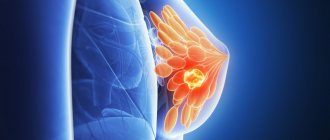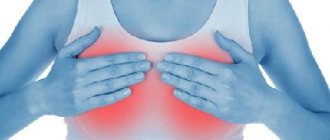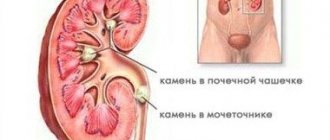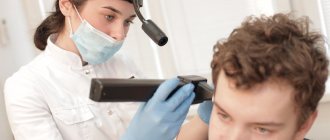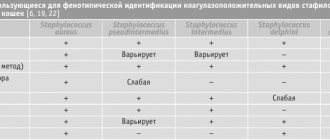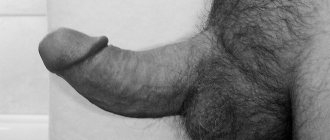The mammary gland is a distinctive feature of an entire zoological class - the class of mammals.
From the birth of a child to the later years of life, the mammary gland changes its appearance many times - starting with a small bud, it goes through its exciting heyday and ends its life in fading calm.
The mammary glands begin to form in the 6th week of intrauterine life. From the moment of birth until puberty, the ducts in the mammary glands lengthen and the nipples enlarge. During puberty, rapid lengthening and branching of the ducts, formation of glandular lobules, and changes in the morphological structure of the mammary gland occur. Connective tissue forms 2 zones: intercellular and interlobar (supporting lobes), subject to hormonal influences. After full puberty, the mammary gland stops developing until the second trimester of the first pregnancy. Thus, from puberty until the end of the first pregnancy, the epithelium of the mammary glands is immature, it is not able to respond to its own circulating progesterone, and this becomes a risk factor in the development of breast cancer.
The mammary gland is extremely dependent on the cyclical physiological processes of the body. In practice, the mammary gland is never at rest, regardless of the woman’s age. Constant variability in the structure of the mammary gland, sensitivity to sex hormones, thyroid hormones, dependence on sexual comfort and the state of the emotional status of a woman, lead to the frequent occurrence of dysplastic processes in this gland, which are most often combined with the term mastopathy or fibrocystic disease.
Mastopathy or fibrocystic disease is a general name for benign changes in the mammary glands, which differ greatly in anatomical features, clinical manifestations and the danger of malignancy, which forces us to consider mastopathy as a precancerous disease.
Causes of the disease
There are a huge number of reasons for the occurrence of pathology. The main ones are:
- Stressful situations that are present in the life of every woman (dissatisfaction with their marital status, as well as their position in society, domestic conflicts, conflict situations at work) since any stress is accompanied by various functional disorders of the neuroendocrine system.
- Factors of a sexual nature.
- Reproductive factors (number of pregnancies, births, abortions, age at pregnancy and childbirth, duration of lactation, time of first menstruation and menopause, etc.).
- Gynecological diseases and, first of all, inflammatory processes in the pelvis.
- Endocrine disorders (thyroid dysfunction, metabolic syndrome, polycystic ovary syndrome, diabetes mellitus types 1 and 20, etc.). Pathological processes in the liver and bile ducts. Hereditary (genetic) predisposition.
Advantages of using gel over tablets
Progestogel is a hormonal drug, but still has significant advantages over systemic drugs. Among them:
- High concentration of the hormone in the application area. When using cutaneous applications, the effect of progesterone increases 10 times.
- Low absorption. Only 10% of the applied substance enters the bloodstream. Studies have shown that 1 hour after applying Progestogel (when its concentration in the glandular tissues is highest), the level of hormones in the blood remains virtually unchanged.
- Additional effect due to the high content of the hormone in breast tissue. Progesterone acts on the glandular epithelium and vasculature of the mammary glands. This helps relieve swelling, which plays a key role in the development of mastalgia during PMS.
- There is no effect of hormones on the liver and other organs. Systemic hormonal drugs affect the entire body and can lead to various complications. Hormonal imbalances affect metabolic processes and can cause subsequent obesity and thyroid diseases. Progestogel does not have such an effect.
It should be borne in mind that mastopathy is a disease caused by an incorrect balance of hormones in the blood. Therefore, the local action of drugs, despite the noticeable effect, is still not considered a full-fledged treatment. For mastopathy, Progestogel is used exclusively as an adjuvant, part of complex therapy.
Symptoms of mastopathy
For mastopathy, the most typical complaints are:
- breast tenderness,
- a feeling of increasing their volume,
- engorgement and swelling of the glands,
- the presence of clear or colostrum-like fluid discharge from the nipples of the mammary glands.
Pain may radiate to the armpits, shoulder and shoulder blade. The most common is a combination of symptoms of mastopathy and premenstrual syndrome. The main complaints in these conditions are: headache (often migraine-type), swelling of the face and limbs, nausea, less often vomiting, impaired bowel function, flatulence. With the neuropsychic form of premenstrual syndrome, complaints such as irritability, depression, weakness, tearfulness and aggressiveness may be associated. Difficulties in determining the cause of pain are due to the fact that pain can occur not only with pathology of the mammary gland, but also with cervicothoracic osteochondrosis, radiculoneuritis, intercostal neuralgia and is eliminated with appropriate therapy.
Gel effectiveness
The gel has undergone clinical trials, so there are accurate statistics on the effectiveness of the product.
- In 80% of women diagnosed with fibrous mastopathy, the pain characteristic of this disease disappears already on the second day of applying the cream.
- After a full course of Progestogel (3 months), symptoms disappear in 90% of patients - pain, hypersensitivity, swelling and discomfort go away.
Judging by the reviews of Progestogel gel for mastopathy, it really helps relieve symptoms. Those who use the gel during PMS, premenopause, and puberty, when the menstrual cycle has not yet stabilized, also speak well of it. In these cases, the remedy successfully controls the symptoms, and for most, breast tenderness does not return. But with severe diffuse mastopathy, the gel, according to many women, helps only for the period of treatment. Pain and heaviness return 2-3 weeks after completion of the course. Doctors explain this low effectiveness of the drug by saying that it was used incorrectly. The use of Progestogel as the only treatment for mastopathy is unacceptable, because it does not affect the cause of the disease and does not correct the synthesis of female sex hormones. Therefore, it is quite natural that after progesterone stops entering the body, mastopathy returns.
What forms can fibrocystic disease have?
Most often, mastopathy is diffuse in nature and manifests itself:
- predominance of the glandular component (edema, proliferation of glandular tissue) - the most favorable form;
- the predominance of the fibrous component (swelling, enlargement of interlobular connective tissue septa, their pressure on the surrounding tissue, narrowing of the lumen of the ducts, up to their complete fusion;
- the predominance of the cystic component (the presence of one or more elastic cavities filled with liquid contents, clearly demarcated from the surrounding tissues of the gland);
- mixed form (increased number of glandular lobules, proliferation of connective tissue interlobar septa).
A less favorable form of mastopathy is nodular. In this form, as a rule, against the background of the changes described above, there is the presence of one or more nodes, most often representing an adenoma or fibroadenoma.
Fibroadenoma is a fairly common benign tumor of the mammary glands. Occurs at any age, but more often in 20-40 years. In some cases, especially in adolescents, fibroadenomas can grow quickly and reach significant sizes (up to 10-15 cm). According to various authors, the degeneration of benign fibroadenoma into a malignant breast tumor occurs in 1.5-2%.
Also, the nodular form can be represented by atypical hyperplasia (proliferation of glandular tissue). The percentage of degeneration of this nodular formation increases to 20%.
It is also worth recalling a very special manifestation of mastopathy - bloody discharge from the nipple of the mammary gland. As a rule, the cause of such discharge is an intraductal formation (papilloma), which can ulcerate and bleed. Such symptoms should be a serious cause for concern for a woman and promptly seek medical help.
Diagnosis of mastopathy
Necessary examination methods that a woman should receive when visiting a mammologist:
- examination and manual examination of the mammary glands, examination of the axillary, subclavian, cervical lymph nodes;
- Ultrasound of the mammary glands and lymph nodes;
- x-ray mammography (all women over 40 years of age);
- blood tests (general analysis, biochemical study, hormonal status, tumor markers);
- when cysts are detected, puncture them with cytological examination of the contents;
- when a nodular formation is detected, cells are collected from the formation using a needle and syringe for cytological examination.
Treatment of mastopathy
The treatment regimen for mastopathy should be selected individually for each woman. When prescribing a regimen, the reasons for the development of mastopathy, examination data, and changes in blood tests should be taken into account. If necessary, a woman should consult such specialists as a neurologist, gynecologist, endocrinologist, or therapist. Also, according to the doctor’s decision, if a nodular formation is identified, surgical treatment can be performed in the oncology department with histological examination of the removed area of the mammary gland.
In her life, almost every woman has at least once felt pain, discomfort in the mammary glands, or independently discovered a lump in the mammary gland. In such a situation, each woman behaves differently. One goes to a mammologist or oncologist, explains the sensations that are troubling her, undergoes an examination and, in the future, either receives a course of treatment or simply receives recommendations on self-examination and the frequency of visits to the mammologist. The other suffers pain, is tormented by doubts, and every time she hears from friends or acquaintances about a cancerous tumor, she thinks, “after all, not everything is all right with me either,” but due to her own fear of hearing a terrible diagnosis or simply from the eternal “not up to herself” continues to put off visiting the doctor.
You can find out more about the work of the hospital by calling +7 (495) 292-39-72.
Nowadays, it is a rare woman who does not have mastopathy. The complicated course of mastopathy today increasingly often ends with puncture of the cyst or even removal of the affected sector of the mammary gland. Therefore, every woman should know the signs of mastopathy and the possibilities of its treatment and prevention.
Mastopathy is a benign disease of the mammary gland, manifested in the pathological proliferation of its tissues. It affects about 8 out of ten women and can, without exaggeration, be called the companion of the modern woman. Mastopathy has a significant impact on overall well-being, and in some cases leads to the development of a serious disease - breast cancer.
One of the distinctive features of the mammary gland is that its normal structure is characterized by great variability depending on age, the state of the reproductive system and the period of the menstrual cycle. In this regard, even doctors sometimes find it difficult to distinguish physiological changes in tissue from pathological ones, as well as determine the type of pathology. Mastopathy has many faces. In fact, we can rather talk about a group of diseases - dishormonal dysplasia (developmental disorders) of the mammary gland - which have a complex clinical and histological picture and are united by the general term mastopathy . Hence the many classifications of mastopathy.
Mastopathy is always associated with a hormonal imbalance in the body. Breast tissue is sensitive to the so-called “hormonal swing” that starts in a woman’s body with the onset of puberty and stops some time after menopause. These swings, in turn, are significantly influenced by many external and internal risk factors, of which there are many.
Menstrual cycle and hormones
The menstrual cycle is regulated by two types of reproductive (steroid) hormones produced by the ovary: from the first day to the middle of the cycle, hormones called estrogens are produced, and from the middle of the cycle, when ovulation occurs, gestagens (progesterone), the level of which in the body reaches a maximum before menstruation. In addition, the mammary gland is constantly influenced by hormones from the adrenal glands, thyroid gland and pituitary gland, which are under the control of the cerebral cortex.
Thus, normally, under the influence of hormones, the mammary gland undergoes monthly cyclic changes in the form of engorgement before menstruation and subsidence after menstruation. If, under the influence of some unfavorable factors, the hormonal balance is disturbed, the production of insufficient or, on the contrary, excessive amounts of hormones provokes pathological proliferation of the ducts, connective (fibrous) and glandular tissues of the breast. At the same time, lumps in the mammary gland, characteristic of the premenstrual period, persist after menstruation.
Some researchers associate pathological changes in breast tissue with an excess of estrogen in a woman’s body, the level of which, under unfavorable conditions, does not decrease to almost zero by the end of the cycle, but remains elevated. The cause of the disease may also be an excess production of the hormone prolactin by the pituitary gland, which stimulates the development of the mammary glands, milk production and forms the maternal instinct.
How mastopathy develops
The disease begins with the proliferation of connective tissue, with the formation of small nodules. This is a diffuse form of mastopathy. Its main manifestation is mastalgia - soreness of the mammary gland, which occurs before menstruation and subsides when it occurs, as well as periodically appearing spherical seals in the upper part of the chest. Often women ignore these symptoms without seeing a doctor for years. And they make a dangerous mistake, since it is at an early stage that mastopathy responds well to conservative treatment.
With further development of the disease, dense nodes ranging in size from a pea to a walnut form in the breast tissue. This form of mastopathy is called nodular . Chest pain becomes more intense and can radiate to the shoulder or armpit. The slightest touch to the chest becomes painful. Colostrum, a bloody or clear fluid, may be discharged from the nipple. When feeling the breast, the lobulation or granularity of the tissue is easily determined. At this stage of the disease, pain and changes in the gland do not disappear with the onset of menstruation. Here you can’t hesitate anymore and you need to urgently go to a mammologist.
Main risk factors
Mastopathy is a multi-cause disease associated with both genetic factors and environmental factors and lifestyle factors of patients.
Heredity The hereditary factor is of primary importance. First of all, this is the presence of benign and malignant diseases in maternal relatives. One of the most common unfavorable factors is inflammation of the uterine appendages, because as a result of inflammation, the production of sex hormones is disorganized.
Abortion One of the first factors that can provoke the development of mastopathy is abortion - a gross intervention in the hormonal system of the female body. As soon as a woman becomes pregnant, the entire body begins to prepare for childbirth. The entire hormonal background is completely restructured. The mammary glands begin to prepare for milk production literally from the first days of pregnancy. And suddenly there is a violent reversal of this process. In this case, it does not matter at all how professionally the abortion was performed. In any case, the body does not forgive such jokes.
Diseases of the thyroid gland Most patients with various forms of mastopathy have pathology of the thyroid gland. Hypofunction of the thyroid gland increases the risk of mastopathy by 3.8 times.
Liver diseases An important reason contributing to the occurrence of mastopathy are various diseases of the liver, bile ducts and gall bladder. The liver plays a very important role in breaking down excess estrogen produced. With her illnesses, this ability is reduced and even lost, as a result of which the hormone content increases.
Obesity Obesity , especially when combined with diabetes and hypertension, may play a role.
Irregular sex life Sometimes even a break in sexual activity can trigger the development of mastopathy. Women's loneliness, lack of stable family relationships - all this contributes to the development of pathological processes in the breast. So, as a preventive measure for the disease, we can recommend improving your personal life, and even better, pregnancy and breastfeeding.
Stress A woman is at greater risk of getting sick when she is stressed, neurosed, or depressed. Prolonged mental stress is one of the leading causative factors in the occurrence of mastopathy.
Bad habits Indirect risk factors are addiction to alcohol and smoking. A direct connection has been identified between the quantity and quality of alcoholic beverages and cigarettes consumed and hormonal imbalance, which is the starting point in the development of mastopathy.
Injuries to the mammary gland Even microtraumas are dangerous when in the subway, on a bus you are pressed, squeezed, or accidentally hit in the chest with an elbow or a bag. In general, you need to develop the habit of protecting your breasts. In addition, underwear plays an important role. Under no circumstances should you wear underwear that tightens, squeezes, rubs or pricks. The skin of the chest is almost twice as thin as that on the face, and therefore requires careful treatment. The bra must be exactly the right size—the underwear should never be too small. Avoid push-ups with metal wires. Tight underwear with metal underwires, although very seductive, tightens the breasts and leads to microtraumas.
It turns out that the development of mastopathy is influenced by a woman’s high socio-economic level (diet, career-related stress, ecology of metropolises, late birth of the first child, etc.). The risk of mastopathy and breast cancer increases under the influence of such unfavorable factors as lack of pregnancy or late first pregnancy, lack of breastfeeding or its short period. Almost all researchers focus on the age at which the first and subsequent births occurred. In particular, women who give birth to two children before the age of 25 have a three times lower risk of developing breast disease compared to those who have only one child. Age is also an important risk factor for cancer. Typically, the incidence of breast cancer increases progressively with age and reaches 30-50% by age 75.
Often all these different factors are in a complex relationship, forming an overall unfavorable background. This is what dictates the need for regular comprehensive examination of the mammary glands (self-examination, mammography, regular consultations with a mammologist) for almost every woman.
Symptoms of mastopathy
— Pain in the chest, shoulder or axillary area — Feeling of fullness, swelling, heaviness in the mammary glands — Dull and aching pain in the mammary glands — Discharge from the nipple (colostrum, serous, sometimes bloody) — Appearance of cracks in the nipples, retraction of the skin or nipple — Hardening, thickening of the mammary glands - Tumor in the mammary gland
— The appearance of “nodes” in the mammary glands — Enlarged lymph nodes in the armpits
Painful sensations can be spontaneous or occur only with pressure, ranging from a feeling of slight pain to distinct tenderness caused by even the touch of clothing to the chest. The pain can be aching, stabbing, radiating to the neck and shoulder.
Also, you should be wary of irregular menstruation, pain before menstruation, discharge from the nipples and any changes in the structure and shape of the mammary glands.
Often women ignore these symptoms, mistakenly believing that pain and swelling before menstruation is the norm. This is wrong. Normally, your breasts should not hurt under any circumstances.
If you find any of the above signs, contact your doctor immediately. Because it is at an early stage that mastopathy responds well to conservative treatment.
Diagnosis and treatment
The main diagnostic methods that provide the most complete picture of the condition of the mammary glands are ultrasound and mammography. To finally confirm the clinical diagnosis and clarify the extent of the process in the mammary gland, the doctor may prescribe additional examinations (blood tests for hormones, cytological and histological examination, etc.). Their necessity in each specific case is determined individually by the mammologist.
Only after a thorough examination, the doctor determines treatment tactics. To effectively treat mastopathy, it is first necessary to identify the form and type of mastopathy, and the causes of its occurrence. That is why proper treatment of mastopathy begins with identifying the cause.
To do this, you need to undergo a standard list of examinations:
- examination by a mammologist - ultrasound of the mammary glands, axillary and clavicular areas on the 5-7th day from the start of menstruation, - blood test for thyroid hormones (T3, T4, TSH), ovarian hormones (progesterone, estradiol, FSH), preferably tumor markers - cytological examination of nipple discharge (if any) - ultrasound of the pelvic organs (uterus, appendages) - consultation with a gynecologist
Only after receiving the results of the examination can you determine the method and amount of necessary treatment that is suitable for you, taking into account your hormonal characteristics and the presence of concomitant diseases.
The lack of a uniform standard for the treatment of mastopathy is explained by the multifactorial nature of the occurrence and development of the disease. Taking this into account, treatment should be individualized depending on your age, the nature of the menstrual cycle, ovarian function, concomitant gynecological diseases (endometriosis, uterine fibroids, endometrial hyperplasia, polycystic ovary syndrome), as well as psycho-emotional status and hypovitaminosis.
Don't self-medicate!
You will not be able to independently determine the type and form of the disease, or identify the cause of its occurrence - only a specialist can do this. This means that you will not be able to choose the necessary and correct treatment, even if you “prescribe” yourself medications for the treatment of mastopathy, which are widely advertised in the media. By self-medicating, you will only delay time, possibly getting rid of the symptoms of the disease for a short time. But since the cause will remain, pain and lumps in the mammary gland will bother you again and again. Only long-term complex treatment under the supervision of a doctor will give the desired result and lead to relief from mastopathy.
By contacting our clinic, you can always get advice from a professional mammologist who is always ready to help you in the diagnosis and professional treatment of mastopathy. Be healthy!
